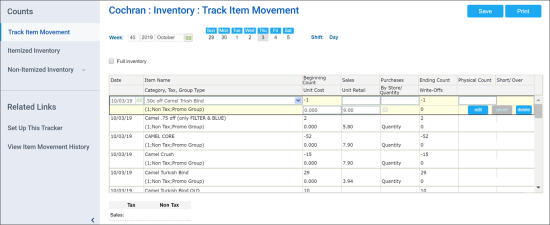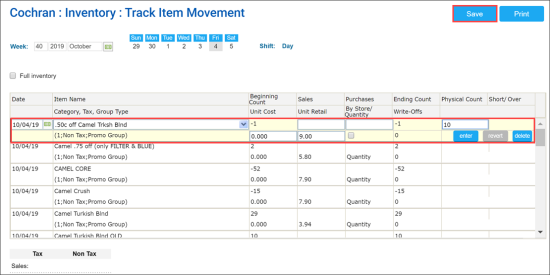To track items with the Track Item Movement form, you should perform the following activities:
Setting Up Item Groups to Be Processed
At this step, you specify what groups of items you want to be counted. It is recommended that you track items by price groups. However, you can also track items by category or item tag.
To set up a category, price or promo group or item tags whose items are to be counted:
- In CStoreOffice®, go to Inventory > Counts.
- In the left menu, select Track Item Movement.
- In the left menu, under the Related Links section, select Set Up This Tracker.
- In the Categories, Price Groups, Promo Groups or item tags sections, select the necessary category, price or promo group or item tags and click Add. For information on item tags setup, see Item Tags.
- At the bottom of the form, click the Save button.
Result: The selected category, group or item tags are added to the Track Item Movement form.
Entering Items Data
Before items counting are entered, make sure shift reports for the necessary day and all invoices with items have been accepted.
To enter items data in the Track Item Movement form:
- Select the Full Inventory option, if you need shorts and adjustments to be included into inventory. In this case, the Short/Over value will be calculated for all rows in the table including the rows with the "0" value in the Physical Count field.
- In the date fields, change the date if necessary. The date should be changed only if a line is entered for a date, not selected in the calendar.
- In the table, select a category, group or item tag to count. The Track Item Movement form provides the following information for each category, group or item tag:
In case the Full Inventory option is not selected:
- The Short/Over value is calculated only for the rows where the Physical Count value is more than "0".
- The Non-Itemized Adjustments and Total Short/Over values are not calculated in the Item Shortage report. For details, see Item Shortage Report.
- The Non-Itemized Adjustments values are not calculated in the Itemized Inventory by Tags report. For details, see Itemized Inventory by Tags Report.
- Item Name: Name of the item or group
- Category, Tax, Group Type: Name of the category or group type with information whether this category or group is taxable or not
- Beginning Count: Inventory as of the beginning of the day
- Unit Cost: Price per the item unit (if set)
- Sales: Information about item sales
- Unit Retail: Selling price per unit
- Purchases: Purchases by store/quantity
- Items can be counted by retail or by quantity. Enter monetary sums (by store) or the quantity of units (quantity) in the Sales, Purchases and other fields.
- To change the account keeping method, in the By Store/Quantity field, select or clear the check box. You can change the accounting method while you are entering item data. The system does not flounder because of it. You can pass from one method to another one and get back.
- Once item data is entered, at the top right of the form, click Save.
Result: The Short/Over amount appears for each group separately. This short/over amount represents the shift that was last counted.
To include into the Short/Over amount all rows in the table including the rows with the with the "0" value in the Physical Count field, select the Full inventory option at the top left of the table.
You can print information about track item movement. To do this, at the top right of the form, click Print.
If there are even small shortages but more than two times in a row, you must take immediate actions:
- Start counting items every shift.
- Watch security cameras to find out if employees are not ringing them up or doing voids.
- Call the supervisor.



